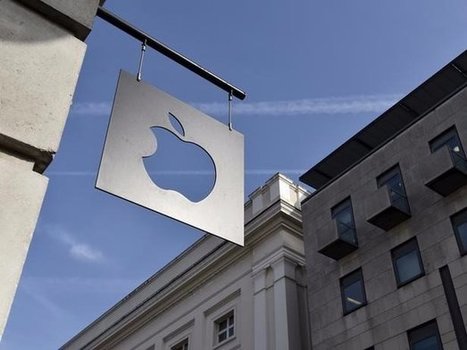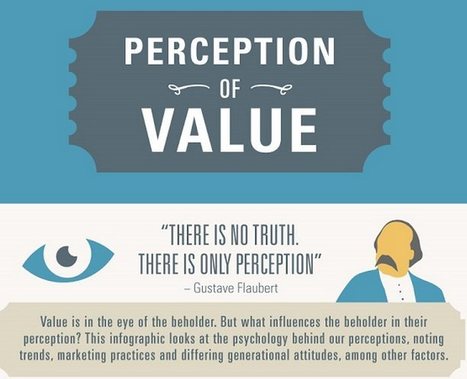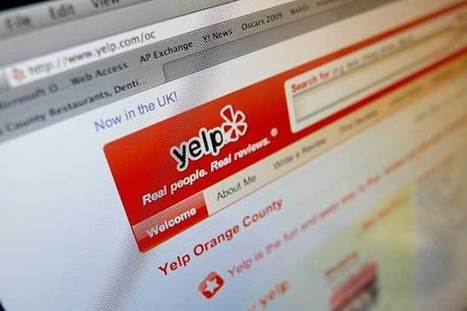 Your new post is loading...
 Your new post is loading...
In SEO’s never-ending evolution, algorithms are continually assessing different elements to determine where brands rank. I remember the time, “back in the day,” when you could often get ahead with only rudimentary SEO tactics like keywords stuffing, e-zine posting, and even article spinning. Oh, but how things have changed. Search engines have never been more sophisticated, and Google is relentless in its pursuits of providing users with the best experience possible. One element of SEO in particular that’s garnered a lot of attention recently is brand signals....
In the era of Facebook and YouTube, brand building has become a vexing challenge. This is not how things were supposed to turn out. A decade ago most companies were heralding the arrival of a new golden age of branding. They hired creative agencies and armies of technologists to insert brands throughout the digital universe. Viral, buzz, memes, stickiness, and form factor became the lingua franca of branding. But despite all the hoopla, such efforts have had very little payoff.
As a central feature of their digital strategy, companies made huge bets on what is often called branded content. The thinking went like this: Social media would allow your company to leapfrog traditional media and forge relationships directly with customers. If you told them great stories and connected with them in real time, your brand would become a hub for a community of consumers. Businesses have invested billions pursuing this vision. Yet few brands have generated meaningful consumer interest online. In fact, social media seems to have made brands less significant. What has gone wrong?
To solve this puzzle, we need to remember that brands succeed when they break through in culture. And branding is a set of techniques designed to generate cultural relevance. Digital technologies have not only created potent new social networks but also dramatically altered how culture works. Digital crowds now serve as very effective and prolific innovators of culture—a phenomenon I call crowdculture. Crowdculture changes the rules of branding—which techniques work and which do not. If we understand crowdculture, then, we can figure out why branded-content strategies have fallen flat—and what alternative branding methods are empowered by social media....
The brands that crush their competition are those who understanding that strategic branding goes much deeper than pretty visuals and responsive code. Branding is layered, sculpted, and tested.
To create a layered, brilliant, and competition-killing brand, three things must align. - Understanding of your brand (internal beliefs and communications)
- Understanding of your best potential audience(s)
- Understanding and differentiating from your competition
Combined, these elements create brand magic. To see these three things in action, keep on reading. Below I’ve curated some brilliant companies that are great at differentiating themselves from their competition....
It’s not an earth-shattering insight that consumers are getting smarter and more skeptical of being sold to. But Wolff Olins and Flamingo’s report does offer some reasonable strategies for adjusting to today’s realities. If you’re still spending all your energy on thinking of ways to pitch and package, you’re in trouble. If you’re thinking of your brand as a static thing, set in stone, you’re behind the times.
The challenge for companies today is coming up with a fair exchange for consumers–one that could involve simple, honest utility, like Ikea, or a more altruistic mission, like Tom’s Shoes, or a broader engagement with the marketplace, like Faber and its academy. No matter what it looks like, if consumers think you’re being honest about the offer, they’ll come to you....
Chipotle was the latest brand to engage in a “fake Twitter hack” marketing stunt, following in the footsteps of MTV and BET a few months ago. The intention behind these stunts is to clearly boost fans and followers for their brands, but, unfortunately, exposes a major flaw in how brand see their customers and how their perception of social is flawed. Furthermore, these types of theatrics deter from the game-change possibilities of how brands and customers can build mutually beneficial and long lasting relationships through these platforms...
The best overall brands in health and beauty, and food and beverage categories are Crest, Gillette, and Dove; and Kellogg, Heinz, and Kraft, respectively, according to a pair of new Forrester rankings based on online surveys this year of 4,500 adults. The Boston-based market research firm argues that brand health comes from the extent to which it is trusted, remarkable, unmistakable, and essential. If you turn that into an acronym, you get Forrester's TRUE formula for brand equity....
Just when you got your SEO mojo, out comes Penguin 2.0, trippin' up your flow. Here's what to do about it! ... Post-Penguin 2.0, the message is clear: if you want to rank and drive real traffic, you need to build your online brand. By strong branding, I’m not talking exclusively about giants like CNN and Zappos et al. I mean a strong brand in relation to the other sites in your industry fighting over specific SERP territory. Say you're a local dentist trying to rank for your best keywords. You won’t ever have brand recognition equal to that of Apple. But you can have an amazingly strong web brand for your local market. And if you do, you’re much more likely to rank. When you think about branding as a ranking factor, it makes a lot more sense. Google is trying to replicate the logic of the “real world” and apply it to the online world, after all. For instance, if you have a business and you’re trying to build your brand as part of a local marketing blitz, how would you do it? What constitutes a strong brand offline? Well, you might have printed ads in the local magazines and newspapers, or maybe radio and television ads -- you know, the kinds of things that might help create some brand recognition for your target market when they're not at a computer or mobile device....
Many social media campaigns focus on individuals, missing the relationships among individuals and the economic power of those relationships. A recent report from Forrester Research found that a third of U.S. marketers surveyed were dissatisfied with their social marketing results. Meanwhile, only 38 percent of those surveyed targeted their fans on social networks, and just 38 percent targeted friends of fans. You would think those results would give marketers pause. Forrester also reports, however, that U.S. marketers are pouring more than $2 billion annually into social media—including ads and promoted content—to try to reach the 1 billion-plus social media users. What many big social media advertisers have failed to grasp is the “social” component of social media. To date, many brands have focused on individuals rather than relationships among individuals and the economic power of those relationships. Who is most likely to influence their friends? Who is most likely to share with friends? Who is most likely to buy or take some other action? Those are vital questions to address to truly unlock the social value of an audience....
|
Millennials make up a crucial group of consumers.
Ad agency Moosylvania asked over 3,500 millennials — defined as 20 to 35-year-olds — to select their favorite brands over the past three years.
Great Questions, LLC helped rank the winning brands.
These brands are the ones that came out on top.
Some are surprising — others, not so much.
A common theme for successful brands? Engaging with millennial consumers via social media....
Value is in the eye of the beholder. But what influences the beholder in their perceptions? This infographic looks at the psychology behind our perceptions, noting trends, marketing practices and differing generational attitudes. Including: - How lobster went from prison food (at one time fetching $0.11/lb) to fine dining
- How ‘ancient grains’ got pricey
- How we experience more pleasure from a wine we’re told costs more
Since price positively influences perceptions of quality, and inversely influences perceptions of value, how do sellers of mundane products use history, story, exclusivity, and implied scarcity to change our appetites? Read on to find out a little more about the Perception of Value...
...Q: In your new book, Absolute Value: What Really Influences Customers in the Age of (Nearly) Perfect Information (HarperBusiness), you and co-author Emanuel Rosen say marketing needs a total overhaul. Can you explain?
A: For the first time in history, people can assess the absolute value of things they buy. User reviews, price comparison apps and other digital tools mean we can buy things based on almost perfect information, instead of irrational perception. So marketers need to understand what influences this shift in decision making...
The changing way in which customers review products can be great for business ... or terrible.
You ask a friend where she got her new Macbook Air and she gushes about the selection and service at her local electronics store so much that you decide to check it out next time you're in her neighborhood. Your boss can't decide where to go out to dinner, so you pull up Yelp on your phone and find a nearby restaurant with the highest ratings. Whether you're aware of it or not, both you and the businesses you patronize benefit from brand advocacy.
Brand advocacy is the latest reincarnation of a concept that most of us are quite familiar with: word–of–mouth advertising, individual recommendations, vouching and the like. It relies on advocates promoting brands via personal marketing, which can be as simple as telling a friend verbally or posting on Facebook.
This method is incredibly effective because of a simple – and very, very human – concept: trust. We trust our friends, the Yelp community, particular bloggers or Twitter personalities who share their preferences and influence our decisions accordingly. From the consumer’s perspective, personal testimony is vastly more relatable than pure numbers, and we value reviews over ratings. How often have you looked at a Yelp or Amazon entry without reading the reviews?...
The Starbucks Coffee marketing research department is kept busy providing oodles and oodles of insights into the Starbucks brand through yearly brand audits. And take it from this former long-time Starbucks marketer: The company learns a lot from these studies.
However, when it comes to measuring and managing the Starbucks brand on a daily basis, the Starbucks marketing department generally relies on a much simpler method—a brand checkbook.
Just as your personal checkbook has credits and debits, a brand checkbook has credits and debits in the form of brand credits and brand debits. "Brand credits" are business activities that enhance the reputation and perception people have of a brand, and "brand debits" are those that detract from the reputation and perception of the brand....
Despite its current popularity, brand reputation management is not a new concept, but today it's about actively managing the references, conversations, and feedback that typically occur online....
So, what course of action should you take? Basically, having a good defense as well as attack strategy is required. Here are seven key areas you should address: - Search engine dominance - Brand monitoring - Social media PR - Reviews and recommendations - Customer service and culture - Negative-PR management- Brand advocacy...
It is no longer all fun and games. A few years back it used to be a lot easier to build and manage a social following or maintain a brand’s online presence. A good old portfolio website and a Facebook brand page with a few hundred fans was all you needed. Now, you need a strategy, a plan, a manager and of course an ‘oh, crap what just happened’ plan. While on the surface it might seem easier than ever to manage a brand, I want you to consider the contrarian take that it is in fact more difficult to manage a brand in the age of new media. Why? Ponder and please comment on these 4 points...
... Nearly 40% of CMOs do not think they have the right people and resources to meet their goals, says an Accenture report entitled “Turbulence for the CMO”. Martin Sorrell, the boss of WPP, the world’s biggest marketing and advertising group, says that since the 2008 financial crisis marketers have been elbowed aside by finance and procurement chiefs. Dominique Turpin, the head of IMD, a Swiss business school, writes that “the CMO is dead”. Yet some have never felt perkier. With new digital tools marketers can reach the likeliest customers when they are most in the mood to buy. Last summer Wall’s ice cream and O2, a mobile-phone network, teamed up to send advertisements to Londoners’ smartphones when temperatures climbed. When the weather cooled Kleenex, a brand of tissues, used Google search terms and health-service data to target ad spending to areas likely to suffer the most sneezes. Andy Fennell, the marketing boss of Diageo, a drinks firm, thinks this is “a golden era for brand builders”....
|



 Your new post is loading...
Your new post is loading...





























Neil Patel shares tips on building SEO by building "brand signals."